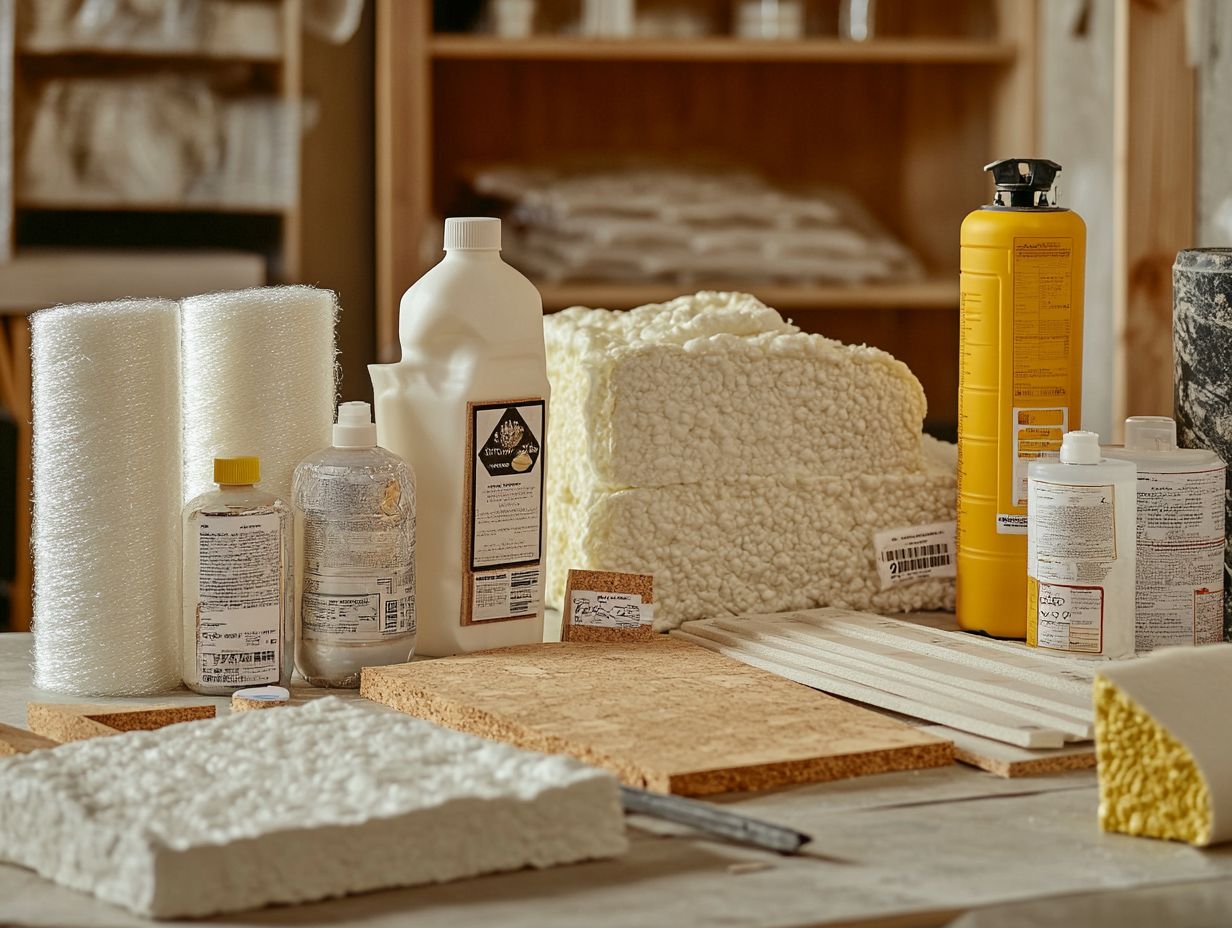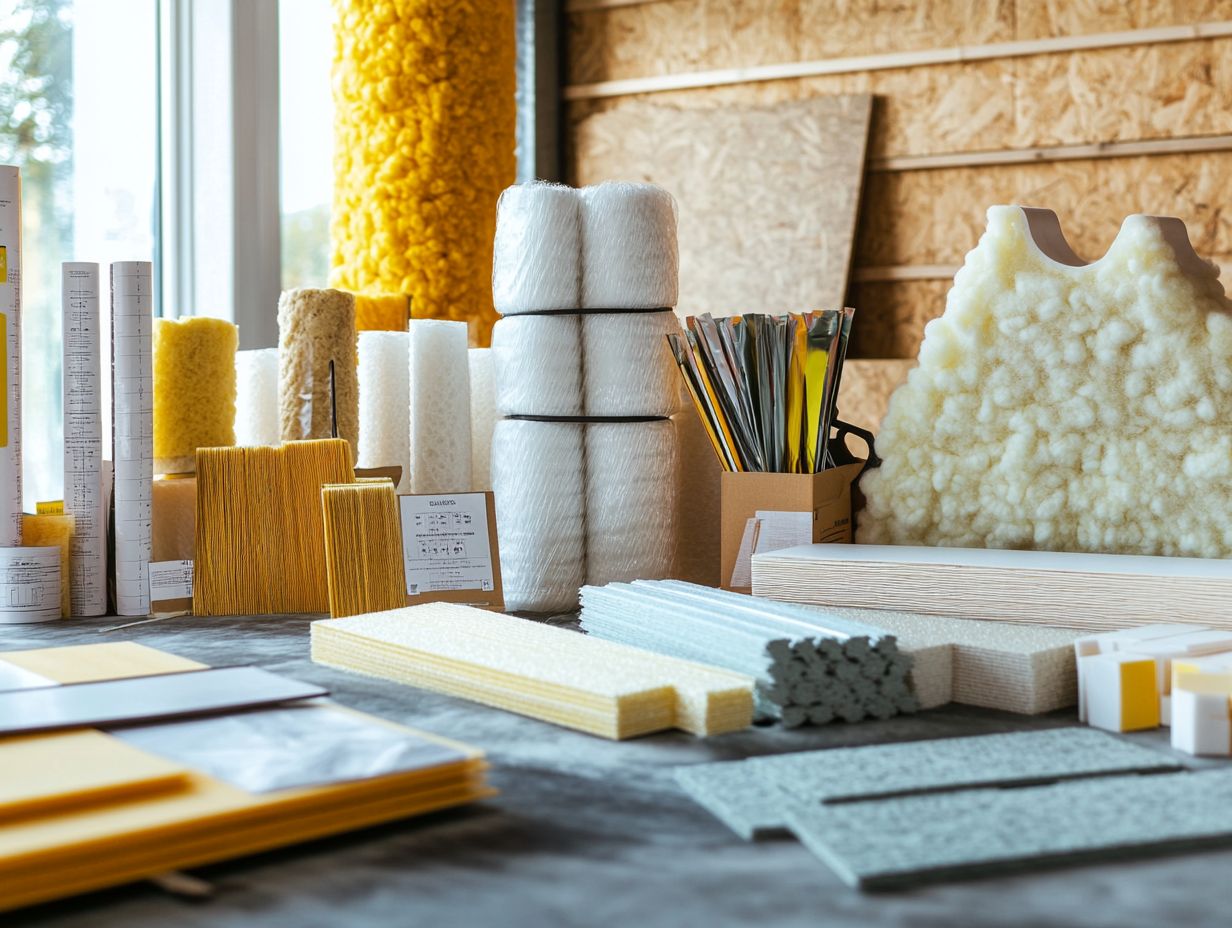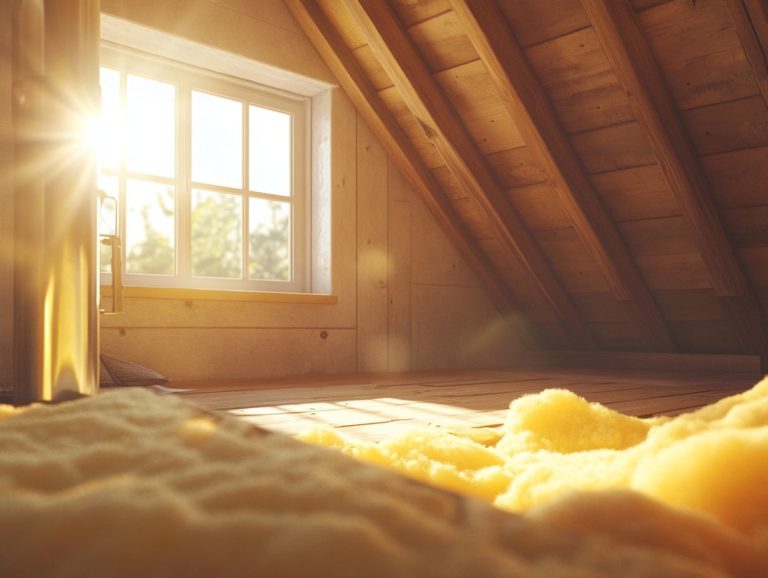How to Choose the Right Insulation Material?
Insulation is essential for creating a comfortable home, effectively regulating temperature, and boosting energy efficiency!
With a plethora of materials at your disposal, selecting the right insulation can feel like navigating a labyrinth.
This guide highlights key factors to consider such as climate, cost, and environmental impact when making your insulation choice.
It delves into various types of insulation materials, weighing their pros and cons. It also offers insights into installation options, whether you re the hands-on DIY type or prefer hiring professionals.
Dive in! Discover how to make the best insulation choice for your home!
Contents
- Key Takeaways:
- What is Insulation and Why is it Important?
- Factors to Consider When Choosing Insulation Material
- Types of Insulation Materials
- Comparing Insulation Materials
- Installation Process and Considerations
- Frequently Asked Questions
- What factors should I consider when choosing the right insulation material?
- What is the R-value and why is it important?
- Which insulation material is best for extreme climates?
- Are there any environmental concerns with certain insulation materials?
- Can I install insulation myself or do I need a professional?
- Is cost the most important factor when choosing an insulation material?
Key Takeaways:

- Consider the climate and location of your home when choosing insulation material to ensure maximum efficiency.
- Take into account your budget and the environmental impact of the insulation material before making a decision.
- Compare the pros and cons of different insulation types and weigh them against your specific needs and preferences.
What is Insulation and Why is it Important?
Insulation is an essential element in both residential and commercial buildings. It enhances heat resistance, reduces energy expenses, and mitigates CO2 emissions.
Insulation serves as a barrier against heat flow, skillfully maintaining your desired indoor temperatures, whether you’re facing the chill of winter or the heat of summer.
Understanding the role of insulation in improving your home’s energy efficiency not only benefits the environment but also leads to significant savings on your energy bills over time.
In today’s world, effective insulation plays a pivotal role in shaping energy consumption habits and overall building comfort. It is a critical aspect of modern construction and renovation practices.
You ll encounter various types of insulation, each tailored to meet distinct construction needs. For instance, fiberglass insulation is a popular choice due to its affordability and effectiveness in resisting heat transfer.
Meanwhile, spray foam offers superior sealing capabilities, effectively preventing air leaks that could undermine energy efficiency.
These materials not only help you achieve higher heat resistance but also contribute significantly to reducing CO2 emissions by minimizing the overall energy required for heating and cooling.
As more homeowners recognize the significance of sustainable practices, choosing the right type of insulation becomes increasingly vital for both environmental stewardship and energy conservation.
Factors to Consider When Choosing Insulation Material
Selecting the ideal insulation material requires careful consideration of several factors, including R-value, air leakage, moisture resistance, and cost.
Each of these elements is crucial in assessing not only the insulation’s effectiveness but also its long-term influence on energy efficiency and the safety of your building.
Make sure your insulation meets building codes. This guarantees safety and performance standards.
As you navigate this decision, it’s essential to weigh the pros and cons of different insulation types, taking into account your specific needs and the local climate conditions.
Climate and Location
The climate and location of your building are crucial for choosing insulation materials. In colder regions, opt for insulation with higher thermal resistance to reduce heat loss.
In warmer climates, focus on moisture resistance to prevent mold growth. Understanding your specific climate helps maintain a consistent indoor temperature and lowers energy costs.
In areas with extreme temperature fluctuations, insulation is even more critical. You may need materials that manage both thermal resistance and moisture control.
Insulation isn t just about reaching desired temperatures; it also prevents condensation. This is essential for avoiding mold when warm air meets cold surfaces.
Choosing insulation designed for your climate boosts your building’s longevity and energy efficiency. This thoughtful choice lowers your carbon footprint and promotes sustainable living.
Cost and Budget
Cost is a key factor when selecting insulation materials. Prices vary significantly between initial investment and long-term savings.
Cheaper options may seem appealing, but effective insulation often leads to substantial savings on heating and cooling bills.
Evaluate your budget by considering the purchase price and energy efficiency. This approach ensures a better return on your investment.
For example, fiberglass insulation costs between $0.50 and $1.00 per square foot. Spray foam insulation costs more, between $1.50 and $3.00, but offers superior efficiency.
Higher-quality options like spray foam can lower energy costs by up to 50% over time. This results in significant annual savings.
Understanding these financial implications empowers you to make informed choices that align with your long-term financial goals.
Environmental Impact

The environmental impact of insulation materials is crucial today. Effective insulation reduces CO2 emissions and enhances energy efficiency.
Choosing eco-friendly materials improves indoor comfort and helps fight climate change. Understanding how insulation choices affect the environment lets you promote sustainability.
Consider cellulose insulation made from recycled paper. It s a sustainable option that reduces waste and conserves resources.
Sheep’s wool insulation is biodegradable and excels at regulating humidity. This enhances comfort while minimizing energy use.
These eco-friendly choices lower the carbon footprint associated with traditional insulation. Making the right insulation decisions fosters a cycle of sustainability that benefits your household and the planet.
Types of Insulation Materials
Explore a variety of insulation materials available today, each designed for your unique needs. Fiberglass insulation is popular due to its cost-effectiveness and versatility.
If you prefer eco-friendly options, cellulose insulation is crafted from recycled paper. For new constructions or renovations, foam board insulation provides excellent thermal resistance.
Want to boost your efficiency? Spray foam insulation creates an airtight seal that reduces air leakage. In hot climates, reflective insulation helps keep your spaces cool.
Natural fiber options, like mineral wool, offer moisture resistance and sustainability. Your insulation choice can greatly impact comfort and efficiency!
Common Types and Their Properties
Understanding the various types of insulation materials and their properties is essential for making informed choices. Each type has unique characteristics and is rated by a measure of insulation’s effectiveness.
When selecting insulation, consider not only the effectiveness ratings but also the applications and environmental footprints of each material. For instance, while fiberglass insulation is often budget-friendly and efficient, it can pose health risks during installation, so protective gear is crucial. To explore more, check out best practices for home insulation.
Cellulose insulation is an eye-catching choice due to its sustainable sourcing, popular among environmentally conscious builders. If you need a compact solution, foam board insulation excels in areas like basement walls.
Spray foam insulation is praised for its exceptional air sealing, leading to significant energy savings. However, it’s important to review its chemical composition. Reflective insulation is effective in regions with extreme heat.
Meanwhile, natural fiber insulation, like mineral wool, offers additional benefits such as soundproofing and fire resistance, showcasing the varied applications of insulation materials.
Comparing Insulation Materials
When comparing insulation materials, engage in a thorough analysis of their advantages and disadvantages, particularly regarding effectiveness ratings and energy efficiency. Each type presents distinct benefits and drawbacks that can significantly impact both your immediate expenses and long-term savings.
By understanding these nuances, you empower yourself to select the insulation material that aligns best with your specific circumstances. Remember that factors such as climate, location, and budget play a crucial role in determining the best choice for your project!
Pros and Cons of Each Type
Each type of insulation material has its advantages and drawbacks that can shape your decision as a homeowner. For example, fiberglass insulation is both affordable and effective, but installation may prove challenging.
On the eco-friendly front, cellulose insulation offers excellent thermal properties, though it may settle over time. If impressive effectiveness ratings and moisture resistance are priorities, foam board insulation is a solid choice.
If you re interested in superior air sealing, spray foam may catch your eye, albeit at a higher price. For hot climates, reflective insulation is advantageous, while natural fibers like mineral wool provide insulation and soundproofing, often at a premium cost.
To make a well-informed choice, weigh your home s specific needs against your local climate and budget constraints. While fiberglass insulation can be budget-friendly, its installation requires protective gear, making it challenging for DIY enthusiasts.
Cellulose insulation is great for the environment, but in moisture-prone areas, it may need special treatment to perform effectively. Each option presents different levels of installation complexity, and understanding these nuances will help you achieve optimal energy efficiency tailored to your lifestyle!
Installation Process and Considerations

The insulation installation process demands careful planning. Whether you choose the DIY route or opt for professional services, effective insulation hinges on proper preparation. Poorly installed materials can result in air leakage and diminished energy efficiency.
Understanding safety measures is essential, particularly when working with materials like Fibreglass or Spray Foam, which may necessitate protective gear. Weighing the benefits of professional installation against the potential cost savings of a DIY approach empowers you to make the best decision for your insulation needs.
DIY vs Professional Installation
When it comes to insulation installation, you find yourself at a crossroads between the DIY route and hiring professional insulation services. Each path presents its own set of advantages and challenges.
Opting for a DIY project may save you some cash and offer a rewarding hands-on experience. However, it also demands a solid understanding of installation techniques to ensure everything works effectively.
On the other hand, while professional installation brings expertise and guarantees compliance with building codes, it does come with a steeper price tag. Knowing the pros and cons of each option empowers you to make informed decisions tailored to your skill level and budget.
For example, if you have a background in construction, you could enjoy the thrill of installing spray foam insulation yourself, potentially pocketing hundreds in labor costs. Testimonials from fellow DIY enthusiasts often praise the satisfaction that comes from completing a project that boosts energy efficiency.
However, cautionary tales abound as well, with some sharing experiences of cutting corners highlighting just how crucial proper sealing and safety precautions can be.
Conversely, bringing in professionals might uncover hidden issues like mold or subpar existing insulation. While initially seeming like an extra expense, this can save you significant funds on future repairs. It s essential to weigh your options thoughtfully before embarking on such a project.
Preparation and Safety Measures
Preparation and safety measures are pivotal to achieving a successful insulation installation, ensuring both effectiveness and risk mitigation. Before diving in, assess the area s insulation needs and gather the appropriate materials and tools.
Don t underestimate the importance of safety; wearing protective gear and ensuring proper ventilation is essential, especially when handling materials like fiberglass or spray foam, which can pose health risks. By addressing these factors, you not only enhance the overall outcome of your installation but also prevent potential issues like air leakage.
Begin your planning with a thorough evaluation of the space to determine the right type and amount of insulation required. It’s wise to familiarize yourself with guidelines from authoritative sources, such as what is the best insulation for homes, to ensure compliance with local building codes.
Equipping yourself with high-quality tools think utility knives, measuring tapes, and staplers can significantly expedite the process. Keeping your workspace clean minimizes distractions and hazards, making your job easier.
Having a first-aid kit readily available is a smart move for addressing any unexpected injuries, paving the way for a smoother and safer installation experience.
Frequently Asked Questions
What factors should I consider when choosing the right insulation material?
When choosing the right insulation material, you should consider factors such as the climate in your location, the area that needs to be insulated, the R-value of the material, and any potential health hazards.
What is the R-value and why is it important?

The R-value measures how well insulation resists heat flow. Higher numbers mean better insulation. It is an important factor to consider as it can impact the energy efficiency and cost savings of your home.
Act now to safeguard your home s energy efficiency!
Which insulation material is best for extreme climates?
For extreme climates, use insulation materials with a high R-value. Spray foam or rigid foam are excellent choices, keeping your home comfy no matter the temperature.
Are there any environmental concerns with certain insulation materials?
Yes, some materials like fiberglass can release harmful particles. Look into eco-friendly options like cellulose or recycled denim insulation instead!
Can I install insulation myself or do I need a professional?
It depends on the material and area. Batt insulation is DIY-friendly, but for spray foam, it’s best to hire a pro.
Is cost the most important factor when choosing an insulation material?
Cost shouldn’t be the only factor in your choice. Some pricier materials can save you money long-term by providing better insulation.






